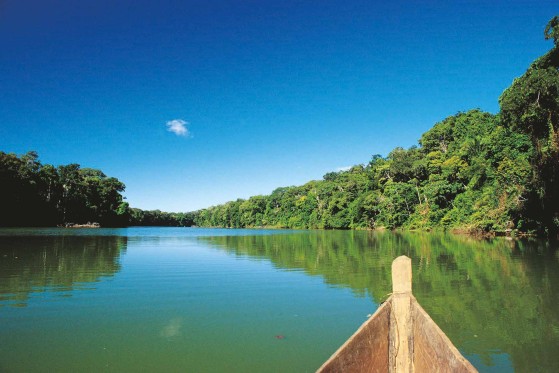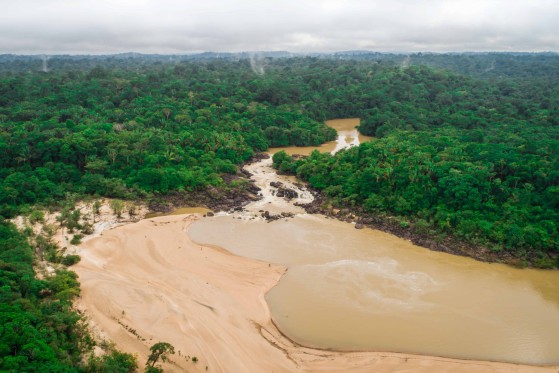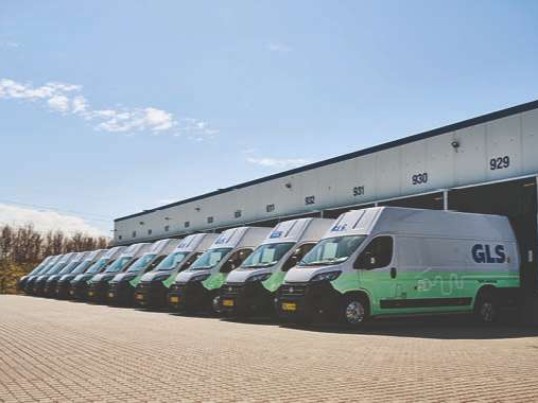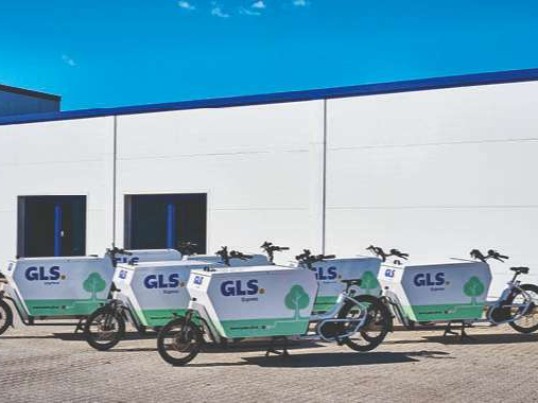Climate Compensation
When you send your parcel with GLS Denmark, we compensate for the CO2e emissions that arise in connection with the transport of parcels and goods, as well as emissions from buildings and business travel (1). We purchase carbon credits in collaboration with ClimatePartner, through which we support climate compensation programmes. Read more below.
GLS' Strategy for Zero Emission
All GLS-countries share our group-wide environmental strategy, Climate Protect, aiming to maximise our impact on environmental protection and ensure that knowledge and efforts are shared and executed across our entire international network. This way we aim to achieve our long-term goal of zero emissions by 2045.
We are continuously working to reduce our CO2e emissions from our business activities as we sort and distribute millions of parcels. As carbon emissions caused by the transportation of parcels account for the majority of our emissions, we focus on the transition from fossil fueled to electric vehicles. But electricity and water consumption in our buildings, responsible procurement, working conditions for employees and in the value chain are also a priority, as are many other environmental, social and governance (ESG) focus areas. Read more about responsibility in GLS Denmark.
Climate Compensation in GLS Denmark
As we work to reduce our greenhouse gas emissions to zero emissions by 2045, GLS Denmark climate compensates the carbon emissions generated by transportation of parcels and freight shipments within GLS Denmark, as well as carbon emissions generated by buildings and business travel.
Projects supported by GLS Denmark
Through GLS Denmark's collaboration with ClimatePartner, we purchase carbon credits in two forest protection projects; Madre de Dios in Peru and Pacajá in Brazil. Both projects are VCS CCBS certified (2).
Questions and Answers About Climate Compensation
What Does Climate Compensation Mean?
Carbon offsetting is a way to offset the CO2e emissions we emit when handling and delivering parcels (1). By purchasing carbon credits in foreign climate projects that avoid CO2e emissions, we compensate for the carbon emissions generated by transportation of parcels and freight shipments within GLS Denmark, as well as carbon emissions generated by buildings and business travel.
The use of climate compensation does not stand alone, but is a complement to our work on reducing CO2e. As it is not yet technologically possible for us not to emit CO2e when sorting and transporting parcels, we have chosen to compensate for our emissions.
Why Does GLS Denmark Compensate for Carbon Emissions?
At GLS Denmark, we take into account the world and society we live in and we have an ambition to deliver your parcels with zero emissions by 2045. We are already investing in charging stations for electric vans and company cars, we have been buying certified green electricity since April 2021, we continuously energy optimise our buildings, and we continuously optimise our routes so that we drive as few kilometres and empty runs as possible. It is not yet technologically possible for us to eliminate all environmentally harmful activities if we are still to deliver your parcels.
Does it Cost Extra to Have Climate Compensated Parcels Delivered?
No, climate compensation is an extra service we offer when our customers send a parcel with GLS Denmark.
What CO2e Emissions Does GLS Denmark Compensate?
Below you can see how the different shipments are covered by climate compensation.
National distribution (drop-off parcels), i.e. parcels dropped off by the customer at a GLS depot in Denmark and distributed by GLS Denmark to an address in Denmark
National distribution (collected parcels), i.e. parcels collected by GLS Denmark and distributed by GLS Denmark to an address in Denmark
National courier shipments with GLS Express Denmark
International courier shipments with GLS Express Denmark
Import parcels, i.e. import parcels delivered by GLS Denmark. If you have a warehouse, shop or webshop abroad, but use a label from GLS Denmark, the parcel is covered by our compensation
Export parcels, i.e. the delivery of export parcels to the recipient address in the import country
Which Emission Sources are Included in GLS Denmark's Climate Compensation?
GLS Denmark compensates for the CO2e emissions generated by our transport of parcels and goods as well as from buildings and business travel. This means that the following scope 1, 2 and 3 emissions are included:
Emissions from company cars, including electricity consumption and well-to-wheel fuel emissions
Operation of sorting facilities, including primarily electricity consumption
Operation of buildings and offices, including electricity, heating and water consumption, paper consumption and waste
Business travel
Transport of shipments, including:
National distribution (handed-in parcels), i.e. parcels handed in by the customer at a GLS depot in Denmark and distributed by GLS Denmark to an address in Denmark
National distribution (collected parcels), i.e. parcels collected by GLS Denmark and distributed by GLS Denmark to an address in Denmark
National courier shipments with GLS Express Denmark
International courier shipments with GLS Express Denmark
Import parcels, i.e. import parcels delivered by GLS Denmark. If you have a warehouse, shop or webshop abroad, but use a label from GLS Denmark, the parcel is covered by our compensation
Export parcels, i.e. the delivery of export parcels to the recipient address in the import country.
How Does GLS Group Calculate Our CO2e Emissions?
We calculate our emissions at group level according to the GHG Protocol, which is a private, transnational standard for companies to calculate and report greenhouse gas emissions.
In GLS Group, we include scope 1, 2 and 3 emissions in our calculation.
Scope 1 = Direct emissions caused by the burning of fuels on company premises, company vehicles and owned transport fleet
Scope 2 = Indirect emissions from the consumption of purchased energy
Scope 3 = Other indirect emissions attributable to third parties
The underlying data for calculating the emissions released due to our business activities is derived from the annual internal life cycle assessment, which is prepared for the entire GLS Group.
As our transport activities make up the largest part of our emissions, we have a special focus on reliable calculations of our transport emissions. The calculation of GLS Group's transport emissions is carried out according to the European standard DIN EN 16258, which is a framework tool for companies in the logistics industry used to calculate and declare our energy consumption and greenhouse gas emissions. The calculation is certified annually by a third party.
At the same time, we use a well-to-wheel approach, where all emissions from fuel extraction and production to combustion are included in the calculation of our transport emissions. This means that the total emissions from our fuel consumption are included in the calculation of our emissions (well-to-wheel), and not just the part that occurs from the tailpipe (tank-to-wheel).
GLS Group calculates all emissions as CO2 equivalents (CO2e), which means that it is not only CO2 that is included in our calculation, but the emissions from a total of seven different greenhouse gases (3).
Which Emission Sources Does GLS Group Include in the Calculation of CO2e?
We calculate our emissions at group level based on the GHG Protocol, which is a private, transnational standard for companies to calculate and report greenhouse gas emissions.
Currently, we include the CO2e emissions generated by:
- Parcel and freight transportation
- Business travel
- Buildings
- Company cars
- Sorting operations
- Office operations
- Transportation of parcels
- Purchase of capital goods
- Employee commuting
- Single consumption factors like water and paper
More emission sources will be added on an ongoing basis as data quality improves and we gain more insight into the emissions generated by our business activities. For example, we have recently calculated the CO2e emissions from our capital goods and employee commuting.
Which Greenhouse Gases Does GLS Denmark Include in Our Climate Compensation?
The GLS Group calculates all emissions as CO2 equivalents (CO2e), which means that emissions from a total of seven different greenhouse gases are included in the calculation. The seven greenhouse gases are carbon dioxide (CO2), sulphur hexafluoride (SF6), methane (CH4), nitrous oxide (N2O), nitrogen trifluoride (NF3), hydrofluorocarbons (HFCS) and perfluorocarbons (PFCS). We use this emissions inventory as it is in line with the Greenhouse Gas Protocol's definition of CO2e.
How is the Amount of Climate Credits Calculated?
After each calendar year, the total CO2e emissions for the entire GLS Group are calculated. These calculations form the basis for the amount of carbon credits that GLS Denmark purchases in collaboration with ClimatePartner.
In practice, when a calendar year ends, the total emissions are calculated in the spring of the following year. Only when this calculation is finalised do we know the emissions that GLS Denmark has had. When we use this calculation method, it results in a gap of up to 1.5 years. We therefore prepay for the carbon credits and then reserve them until we know our actual emissions. If our emissions do not match the amount of carbon credits, the amount of carbon credits are adjusted so that we compensate for all the emissions caused by the transportation of parcels, as well as the carbon emissions from our buildings and business travels from this year.
Who Is ClimatePartner?
The projects GLS Denmark supports with the purchase of climate credits are facilitated by our partner, ClimatePartner. The company offers climate action through their portfolio of verified projects. In addition to the projects' positive impact on the climate, they also provide benefits to local communities based on the UN Sustainable Development Goals.
ClimatePartner has created a brochure that describes what climate projects are, due diligence, regulation and a description of standards, including the Verified Carbon Standard.
Read the brochure , or learn more about ClimatePartner .
Which Certification Standards Do the Projects GLS Denmark Buys Carbon Credits From Use?
The organisation VERRA has the VCS standard, which focuses on the avoidance of emissions (such as forest protection), while the CCBS certification - which is a supplementary standard to the VCS - focuses on social issues.
See our certificate from ClimatePartner.
Verified Carbon Standard (VCS) has a strong focus on nature-based projects and renewable energy. It is the world's most widely used greenhouse gas (GHG) crediting programme. VCS makes investments in activities that reduce and eliminate emissions, improve livelihoods and protect nature. The VCS has strict rules and requirements, including adaptation to new science and technologies, transparent information about project activities, and that emission reductions and removals are real, permanent, measurable and verified by independent parties.
Climate Community and Biodiversity Standard (CCBS) focuses on projects that address biodiversity. Being certified with CCBS involves different rules and requirements, as a CCBS certification demonstrates that a project addresses climate change, supports local communities and conserves biodiversity. Projects that wish to be included under CCBS must go through a development and assessment process.
How Can GLS Denmark Use Forest Protection as Climate Compensation?
Climate compensation is a term for projects that avoid or reduce carbon emissions and where it is possible to purchase carbon credits in the project. The purpose of purchasing carbon credits is to reduce (e.g. planting new trees) or avoid (e.g. forest protection) CO2 emissions into the atmosphere.
At GLS Denmark, we care about our effect on the world around us and the society we are part of. In our efforts to achieve zero emissions by 2045, we therefore use carbon offsetting as a supplement to our ongoing efforts to reduce our CO2e emissions. When we climate compensate, it does not mean that we are reducing our own carbon footprint. It means that we buy carbon credits from foreign projects that avoid CO2 emissions from being emitted into the atmosphere.
For example, to avoid CO2 emissions into the atmosphere, carbon credits can be purchased from forest protection projects in areas where there has historically been extensive logging, where there is a financial incentive for deforestation for the resale of timber, or where there are plans to expand infrastructure projects that do not favour the forest and its ecosystem. What the three aforementioned scenarios have in common is that when companies support these forest protection projects, NGOs and other organisations can work to ensure that the trees are not cut down. If a tree is cut down, its captured CO2 is released into the atmosphere, but if a tree is not cut down, its sequestered CO2 remains in the tree. Since the purpose of purchasing carbon credits in forest protection projects is to ensure that the trees are not felled and thus remain as part of the ecosystem, the forest protection project has resulted in the avoidance of CO2 emissions into the atmosphere.
And as an added bonus, we automatically compensate for the delivery of the parcels our customers and recipients send with GLS Denmark (1).
Footnotes
(1) See 'Which Emission Sources are Included in GLS Denmark's Climate Compensation?'
(2) See ' Which Certification Standards Do the Projects GLS Denmark Buys Carbon Credits From Use?'
(3) See 'Which Greenhouse Gases Does GLS Denmark Include in Our Climate Compensation?'



